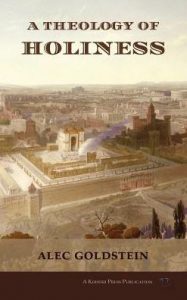 A Theology of Holiness
A Theology of Holiness
Alec Goldstein
Kodesh Press
258 pages
Chapter 8 of this book starts with a quote from Socrates: “What is piety? That is an enquiry which I shall never weary of pursuing.” That quote might as well have come from the author given the origins of this book.
While in Yeshiva University, Alec Goldstein took a course in “Hebrew Semantics and Lexicography.” For his final paper, Goldstein selected to analyze the semantic overlap of the words kodesh (holy) and tahor (pure). He writes, “I became fixated on every aspect of this relationship: linguistic…, anthropological, exegetical, literary, and philosophical.” The result of Goldstein’s obsession is that he never completed the assignment but his voluminous research in this area has surfaced in the form of A Theology of Holiness. (Also please note the name of the publishing house founded by Goldstein – Kodesh Press! Truly, this project represents a lifetime commitment on the author’s part.)
As an author of books and articles on Jewish thought, I tend to treat the Hebrew word KDSh as if it means “unique.” God is kadosh because there is no other being like Him. The Torah is kadoshah because it’s the only book dictated by God. The Jews are kedoshim because they are God’s chosen people. Israel is kodesh because it’s God’s chosen land. And yet, even as I’m treating KDSh as “unique,” I know that it’s far from a perfect approach. “Unique” is an absolute – something can’t be “a little unique” – but there are degrees of holiness. In the Temple, there was the Kodesh and the Kodesh HaKedoshim – the “Holy” and the “Holy of Holies,” respectively. Similarly, sacrifices included kodshim kalim – offerings of a lighter degree of sanctity. If something can be “more holy” or “less holy,” holiness is clearly not “unique.” So what is it? To paraphrase Supreme Court Justice Potter Stewart, we may not be able to define holiness but we know it when we see it.
Or do we? And therein lies the premise of the current work.
Unsurprisingly, the first section addresses the linguistics of KDSh, not just in relation to THR (purity) but also in relation to PRSh (separation), ZMN (preparation), ChNK (inauguration) and other concepts. Most striking, to the extent of warranting its own section, is the “fourfold relationship” among KDSh, THR, ChLL and TM’ (holiness, purity, desecration and impurity, respectively). Have you considered the conceptual similarity between things that are holy and those that are ritually impure? Each is restricted for use, albeit for diametrically opposed reasons. And yet, while impurity and holiness may serve as conceptual opposites, they are not lexical opposites.
And then there’s meilah (trespass). This is not a term that we would normally contrast with kedusha and yet Devarim 32:51 does exactly that. There are many such concepts that are inextricably bound with that of kedusha in ways we might not have imagined.
Those with less of an interest in linguistics and etymology might be tempted to skip the first section and head straight for “Comprehensive Theories of Holiness,” but not only is the linguistic analysis an integral part of the work, it forms the foundation on which the rest is built.
Subsequent sections include “Holiness of God and Man,” “Holiness of Place, Time, and Objects,” “Biblical Understanding of ‘Being Holy,’” “Hellenistic Holiness,” “Talmudic Holiness,” and the aforementioned “Comprehensive Theories of Holiness.” The volume of scholarship collected is beyond impressive. It appears so daunting that one is amazed Goldstein was ever able to complete his research!
Obviously, the full gamut of Torah sources is represented, from Bible verses to Talmudic interpretations, and from Rambam and Kuzari to Rav Hirsch and Rav Soloveitchik, but there’s so much more.
We are treated to concepts of holiness from the ancient Near East, predating the giving of the Torah, in which holiness was limited to their deities. Only with the coming of Judaism was holiness something towards which the average person might aspire.
Socrates takes center stage in the section on Hellenistic Holiness, with emphasis on his works Euthyphro and, to a lesser extent, Protagoras. The work of Immanuel Kant also features fairly prominently, and was possibly an influence on the approach of Rav Hirsch. Authorities cited go all the way up to Prof. Burton Leiser (d. 2009), who observed that “the statements ‘This is sandy ground’ and ‘This is holy ground’ look very much alike” but the latter doesn’t tell us very much about the ground at all, illustrating that holiness refers to a “series of relationships” about an object rather than to an object’s quantifiable attributes.
In case it was unclear, make no mistake: A Theology of Holiness is no light reading. It’s an academic work that encompasses the breadth of Torah literature on the subject of kedusha and extends its branches into relevant works in related disciplines, linguistic, historical and philosophical. This approach might be a little much for some people’s pleasure reading but its indispensable if one hopes to broach the development of our understanding of kedusha in any significant way.
Rabbi Jack Abramowitz is Torah Content Editor at the Orthodox Union. He is the author of six books, including The Tzniyus Book and The Taryag Companion. His latest work, The God Book, is available from OU Press as well as on Amazon.
The words of this author reflect his/her own opinions and do not necessarily represent the official position of the Orthodox Union.

